
Copivaleria is a monotypic moth genus of the family Noctuidae erected by Augustus Radcliffe Grote in 1883. Its only species, Copivaleria grotei, or Grote's sallow, was first described by Herbert Knowles Morrison in 1874. It is found in eastern North America, including Ontario, Tennessee, New York and Maryland.
Melanomma auricinctaria, the gold-lined melanomma moth, is the only species in the monotypic moth genus Melanomma of the family Erebidae. It is found in the United States and Canada. Both the genus and species were first described by Augustus Radcliffe Grote in 1875.

Feralia comstocki, or Comstock's sallow, is a moth of the family Noctuidae. The species was first described by Augustus Radcliffe Grote in 1874. It is found in North America from the southern Appalachians north to the Maritime provinces, east across the southern boreal forest to Vancouver Island, south to Oregon. In Alberta, the species has been collected from the Lake Athabasca and Zama areas south to about Pigeon Lake.

Catocala semirelicta, the semirelict underwing, is a moth of the family Erebidae. The species was first described by Augustus Radcliffe Grote in 1874. It is found in North America from Nevada, Colorado, Utah, California, and Nova Scotia south to Maine, west across Canada to British Columbia, and southward in the mountains.

Acronicta dactylina, the fingered dagger moth or alder dagger, is a moth of the family Noctuidae. The species was first described by Augustus Radcliffe Grote in 1874. It is found from Newfoundland west to the Pacific coast and Vancouver Island and Haida Gwaii, British Columbia, south to North Carolina and Colorado.
Apamea inficita, the lined Quaker is a moth of the family Noctuidae. The species was first described by Francis Walker in 1857. It is native to North America, where it can be found from Newfoundland west to British Columbia, north to the Yukon and the Northwest Territories, and south to Colorado.

Apamea plutonia, the dusky Quaker or dusky apamea, is a moth of the family Noctuidae. The species was first described by Augustus Radcliffe Grote in 1883. It is native to northern North America, where it occurs across the boreal regions, with some occurrences from as far south as New Mexico and Pennsylvania.
Capsula oblonga, the oblong sedge borer, is a moth of the family Noctuidae. The species was first described by Augustus Radcliffe Grote in 1882. It is found across southern Canada from the Maritimes to British Columbia, south to the Gulf of Mexico and southern California.
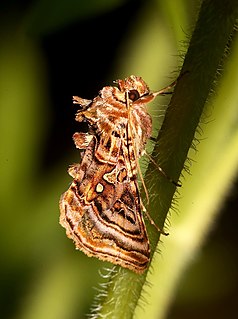
Autographa mappa, the wavy chestnut Y, is a moth of the family Noctuidae. The species was first described by Augustus Radcliffe Grote and Coleman Townsend Robinson in 1868. It is found in North America from Newfoundland west across the wooded portions of Canada to Vancouver Island, south in the east to Maine, New Hampshire and Wisconsin, and in the western mountains south to Colorado and Oregon.
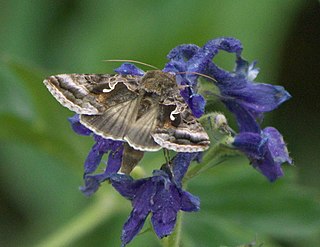
Autographa pseudogamma, the delicate silver Y, is a moth of the family Noctuidae. The species was first described by Augustus Radcliffe Grote in 1875. It is found in North America from Newfoundland to coastal northern Alaska, south in the east to New England and in the western mountains to New Mexico, Arizona and California. It is also found in the Cypress Hills and the Black Hills of South Dakota.
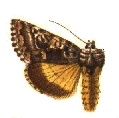
Syngrapha octoscripta, the figure-eight looper moth or dusky silver Y, is a moth of the family Noctuidae. The species was first described by Augustus Radcliffe Grote in 1874. It is found in North America from coast to coast in most of Canada south in the east to northern Pennsylvania, Ohio, and the Great Lakes states.

Syngrapha epigaea, the pirate looper moth or narrow silver Y, is a moth of the family Noctuidae. The species was first described by Augustus Radcliffe Grote in 1874. It is found from coast to coast in Canada south in the east to Pennsylvania, Ohio, and the northern Great Lakes states.
Photedes defecta, the narrow-winged borer, is a moth of the family Noctuidae. The species was first described by Augustus Radcliffe Grote in 1874. It is found in North America from Maryland and Massachusetts north to New Brunswick, west to North Dakota and British Columbia.
Xestia normaniana, or Norman's dart, is a moth of the family Noctuidae. The species was first described by Augustus Radcliffe Grote in 1874. It is found in North America from Nova Scotia across southern and central Canada to Alberta. In the eastern United States it ranges from Maine to eastern Minnesota, and south along the Appalachians to western North Carolina. It has recently been recorded from Tennessee.
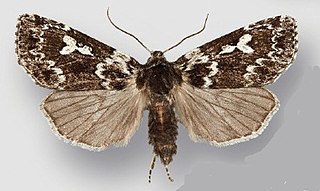
Xestia perquiritata, the boomerang dart, is a moth of the family Noctuidae. The species was first described by Herbert Knowles Morrison in 1874. It is found across North America from Newfoundland, Labrador and northern New England, west to central Yukon, British Columbia and Washington. There are several disjunct populations, including one in the Great Smoky Mountains National Park and the Rocky Mountains in Colorado and a coastal bog in central Oregon.
Coenophila opacifrons, the blueberry dart or plain-faced blueberry dart, is a moth of the family Noctuidae. The species was first described by Augustus Radcliffe Grote in 1878. It is found in North America from Labrador and Newfoundland, south to New Jersey, west across the boreal forest to eastern British Columbia, south in the mountains to southern Montana.
Melaporphyria immortua, the dark-banded flower gem, is a moth of the family Noctuidae. The species was first described by Augustus Radcliffe Grote in 1874. It is found in North America from New England west to Colorado, north to southern Manitoba, central Saskatchewan and Alberta.

Pleromelloida conserta is a moth of the family Noctuidae first described by Augustus Radcliffe Grote in 1881. It is found in North America from British Columbia to California, east to Utah, north to Saskatchewan.
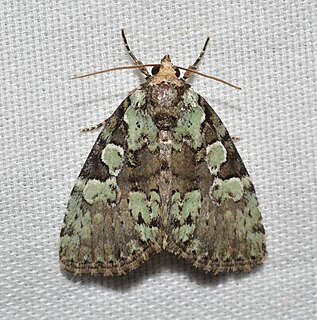
Leuconycta lepidula, the marbled-green leuconycta moth, marbled-green jaspidia or dark leuconycta, is a moth of the family Noctuidae. The species was first described by Augustus Radcliffe Grote in 1874. It is found in North America from Nova Scotia to North Carolina, west to Texas and north to Alberta.

Plagiomimicus spumosum, the frothy moth, is a moth of the family Noctuidae. The species was first described by Augustus Radcliffe Grote in 1874. It is found in North America, where it has a transcontinental range in the United States, north to southern Ontario and southern Alberta.











